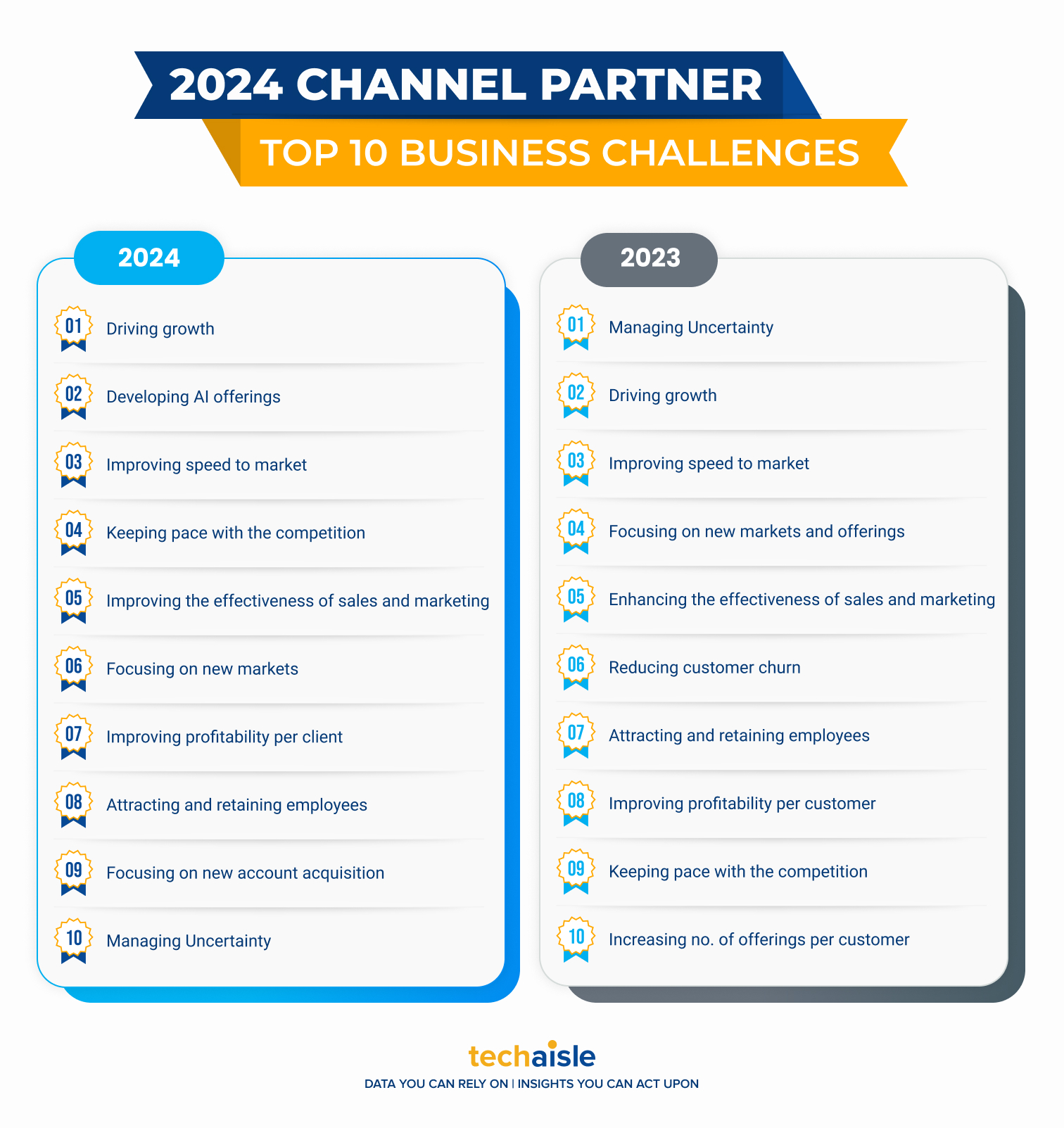To get a clear picture of how a channel adapts to market change, Techaisle interviewed 2,115 channel firms. Survey data shows dramatic year-over-year changes in channel business priorities. At the top level, last year’s channel was mainly worried about handling uncertainty, while this year’s channel is focused on growth. In 2024, worries about uncertainty have almost dropped out of the top 10 channel business issues, overtaken by agility, competitiveness, and business process improvement goals. The second-highest priority for the 2024 channel, “developing AI offerings,” was not even a choice in 2023. AI is creating a strong attraction for the channel because it is changing the market that the channel serves. Channel firms that thrive through the transition to AI-inclusive technology and business infrastructure must quickly abandon legacy assumptions about how they operate, the services they offer, and the buyers they serve within client accounts.
Techaisle Blog
Techaisle’s landmark survey of 2,115 channel partners, representing a cross-section of the partner community, indicates that while pressure for change is mounting, partners have not yet coalesced around a path forward. The Techaisle channel survey shows that the partner community members are searching for a roadmap to success. That roadmap will vary across partner models, as will the opportunities and requirements for suppliers. In this time of transition, effective channel collaboration will determine growth and viability for both individual channel businesses and their vendor suppliers.
The early years of this decade have been challenging for individuals and businesses in all sectors. In some cases, the pandemic – or, more recently, rising interest rates and declining consumer confidence – have caused tremendous upheaval, with suppliers finding that traditional definitions of the market, sales motions, and fulfillment no longer applied.
The current decade has brought an even thornier set of challenges to the IT channel. In addition to the macro conditions that apply to all businesses, and against a backdrop of changing business models, shrinking product margins, and the need to build profitable services practices, channel members need strategies to cope with:
• A shift in core customers – from technologists to an organization-wide mix of personas, including businesspeople who define technology in terms of business rather than IT functionality.
• A shift in buying and selling models – from fee-for-product/service to approaches that involve outcome-based evaluation and contracting or shared risk agreements that tie payments to achieving defined business goals.
• A shift in solution composition – from monolithic systems to modular stacks that address target functionality via APIs – as well as a corresponding change in the underlying business approach, from “design once, deploy many” to a need for individualized solutions tailored to a fluid set of customer needs.
These conditions have combined to place the channel under tremendous stress. Channel members have explored different business models, different product mixes – accompanied by demands for new skills and service capabilities – and other marketing, selling, and partner relationship configurations.
Both channel businesses and their vendor suppliers are vested in understanding how solution portfolios are changing and how the channel and vendor communities can best work together to bring solutions to market. These are complex questions, but their answers are at the heart of a wide range of sales, marketing, and executive imperatives. This study provides valuable input to those discussions.
Aligning to Changing Solution Portfolios
The starting point for an analysis of alignment to changing solution portfolios is the portfolios themselves – what is the channel selling, and how fast is revenue associated with these offerings expected to grow? Data shows that more than 80% of partner firms are selling cloud and/or collaboration, and more than 60% sell customer experience, employee experience, or analytics solutions. From a growth perspective, 80% or more of channel members anticipate growth in cloud and 5G, and 70% or more expect growth in collaboration, analytics, SD-WAN, virtualization, and/or SD-WAN.
Techaisle’s survey of 2115 partners shows that while many VARs offer managed services to their customers, only a small percentage successfully achieve consistent growth and profitability. In contrast, MSPs have been more successful in their managed services business model and have also begun to achieve success in the cloud. MSPs are well aligned with the business requirements associated with cloud sales. They can act as a logical extension to partner activities by providing discrete services that can be delivered efficiently. However, unique business requirements and partnering practices associated with cloud suppliers have proved challenging for MSPs.
Techaisle data shows that 65% of VARs offer managed services to their customers. Still, only 50%, less than one-third of all VARs, successfully achieve consistent growth and profitability within managed services. The data is similar to 2018. Conversely, 71% of MSPs have succeeded in their managed services business model, and 29% are still striving to achieve profitability and success. Unlike the last several years, MSPs have begun to achieve success in the cloud. 89% of MSPs currently offer cloud, and 72% have achieved cloud success. It is two-thirds of all MSPs, up from less than half in 2018.
Techaisle's Channel partner ecosystem research contains a wealth of information, a great value to partner management teams looking to validate their partner program investments' alignment with real-world conditions, preferences, and requirements. The research contains reliable insight drawn from over 2000 channel partners survey (leveraging network of 225K channel members) with channel decision-makers from firms representing five significant channel types businesses to reflect an outlook shaped by the pandemic and its impact on both the channel and its customers. There are six observations, though, that we believe will help readers to better grasp the implications of many of research findings and where changes are afoot in 2021.
-
Focus on efficiency and control
-
Hybrid everywhere
-
Data and systems of insight
-
Cloud and the transformation of business
-
Digital transformation as a key to growth/viability
-
Relationships defined by ecosystems, not discrete connections












